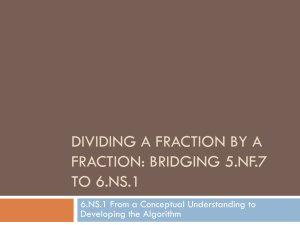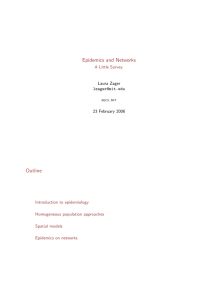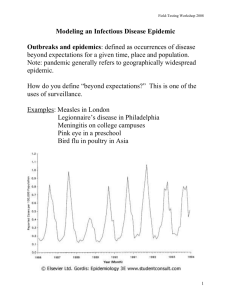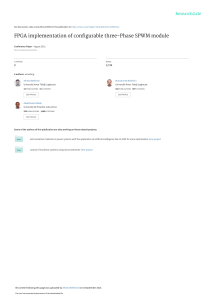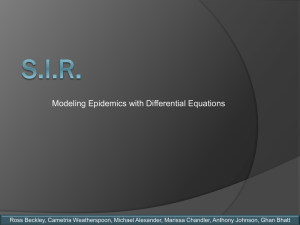SIR and SIRS Models
advertisement
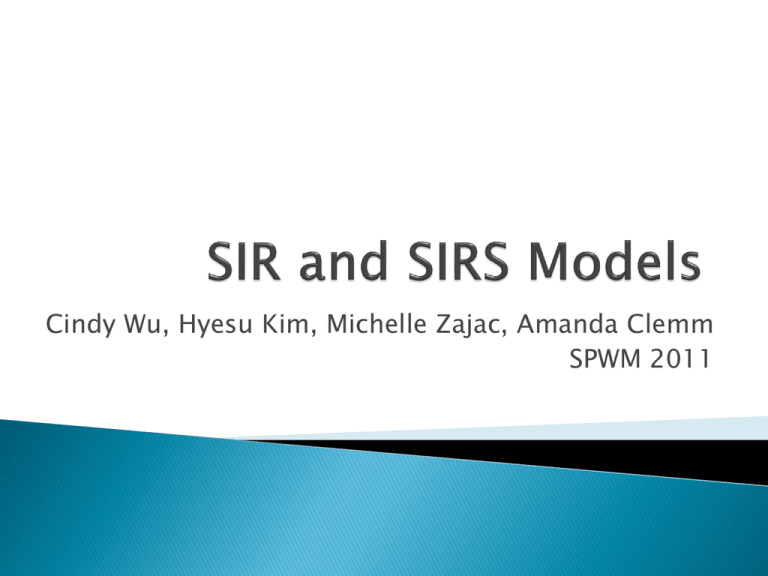
Cindy Wu, Hyesu Kim, Michelle Zajac, Amanda Clemm SPWM 2011 Cindy Wu Gonzaga University Dr. Burke Hyesu Kim Manhattan College Dr. Tyler Michelle Zajac Alfred University Dr. Petrillo Amanda Clemm Scripps College Dr. Ou Why Math? Friends Coolest thing you learned Number Theory Why SPWM? DC>Spokane Otherwise, unproductive Why math? ◦ Common language ◦ Challenging Coolest thing you learned ◦ Math is everywhere ◦ Anything is possible Why SPWM? ◦ Work or grad school? ◦ Possible careers Why math? ◦ Interesting ◦ Challenging Coolest Thing you Learned ◦ RSA Cryptosystem Why SPWM? ◦ Grad school ◦ Learn something new Why Math? ◦ Applications ◦ Challenge Coolest Thing you Learned ◦ Infinitude of the primes Why SPWM? ◦ Life after college ◦ DC Study of disease occurrence Actual experiments vs Models Prevention and control procedures Epidemic: Unusually large, short term outbreak of a disease Endemic: The disease persists Vital Dynamics: Births and natural deaths accounted for Vital Dynamics play a bigger part in an endemic Total population=N ( a constant) Population fractions ◦ S(t)=susceptible pop. fraction ◦ I(t)=infected pop. fraction ◦ R(t)=removed pop. fraction Both are epidemiological models that compute the number of people infected with a contagious illness in a population over time SIR: Those infected that recover gain permanent immunity (ODE) SIRS: Those infected that recover gain temporary immunity (DDE) NOTE: Person to person contact only λ=daily contact rate ◦ Homogeneously mixing ◦ Does not change seasonally γ =daily recovery removal rate σ=λ/ γ ◦ The contact number Model for infection that confers permanent immunity Compartmental diagram λSNI NS Susceptibles ϒNI NI Infectives (NS(t))’=-λSNI (NI(t))’= λSNI- γNI (NR(t))’= γNI NR Removeds S’(t)=-λSI I’(t)=λSI-ϒI S’(t)=-λSI I’(t)=λSI-ϒI Let S(t) and I(t) be solutions of this system. CASE ONE: σS₀≤1 ◦ I(t) decreases to 0 as t goes to infinity (no epidemic) CASE TWO: σS₀>1 ◦ I(t) increases up to a maximum of: 1-R₀-1/σ-ln(σS₀)/σ Then it decreases to 0 as t goes to infinity (epidemic) σS₀=(S₀λ)/ϒ Initial Susceptible population fraction Daily contact rate Daily recovery removal rate dS/dt=μ[1-S(t)]-ΒI(t)S(t)+r γ γ e-μτI(t-τ) dI/dt=ΒI(t)S(t)-(μ+γ)I(t) dR/dt=γI(t)-μR(t)-rγγe-μτI(t-τ) μ=death rate Β=transmission coefficient γ=recovery rate τ=amount of time before re-susceptibility e-μτ=fraction who recover at time t-τ who survive to time t rγ=fraction of pop. that become re-susceptible Focus on the endemic steady state (R0S=1) Reproductive number: R0=Β/(μ+γ) Sc=1/R0 Ic=[(μ/Β)(ℛ0-1)]/[1-(rγγ)(e-μτ )/(μ+γ)] Our goal is now to determine stability dx/dt=-y-εx(a+by)+ry(t-τ) dy/dt=x(1+y) where ε=√(μΒ)/γ2<<1 and r=(e-μτ rγγ)/(μ+γ) and a, b are really close to 1 Rescaled equation for r is a primary control parameter r is the fraction of those in S who return to S after being infected r=(e-μτ rγγ)/(μ+γ) What does rγ=1 mean? Thus, r max=γ e-μτ /(μ+γ) So we have: 0≤r≤ r max<1 λ2+εaλ+1-re-λτ=0 Note: When r=0, the delay term is removed leaving a scaled SIR model such that the endemic steady state is stable for R0>1 In our ODE we represented an epidemic DDE case more accurately represents longer term population behavior Changing the delay and resusceptible value changes the models behavior Better prevention and control strategies


